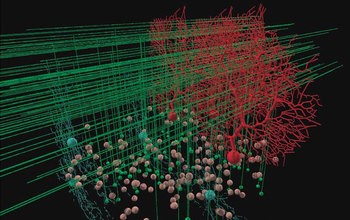The National Science Foundation (NSF) has made cyberinfrastructure a central theme in its plans for developing and delivering tools to enhance scientific discovery.
This year, between January and April, the NSF sought input from the research community on science challenges and associated cyberinfrastructure needs over the next decade and beyond. The federal agency was looking for bold, forward-looking ideas to help advance the frontiers of science and engineering over the next decade and beyond (NSF CI 2030). This activity also recognized that researchers in varying disciplines may need different resources; may have differing priorities for access, interoperability, and continuity; and may require external expertise to address the most critical problems in their specific disciplines.
Please refer to Dear Colleague Letter (DCL) NSF 17-31 for full background information on this activity.
What is Cyberinfrastructure?
 Cyberinfrastructure was first used by the NSF to describe research environments that support advanced data acquisition, data storage, data management, data integration, data mining, data visualization and other computing and information processing services distributed over high-speed networks beyond the scope of a single institution. It is classified as a technological and sociological solution to the problem of efficiently connecting laboratories, data, computers, and people to find that next great innovation or discovery.
Cyberinfrastructure was first used by the NSF to describe research environments that support advanced data acquisition, data storage, data management, data integration, data mining, data visualization and other computing and information processing services distributed over high-speed networks beyond the scope of a single institution. It is classified as a technological and sociological solution to the problem of efficiently connecting laboratories, data, computers, and people to find that next great innovation or discovery.
In 2009, NSF undertook a community-informed analysis of cyberinfrastructure needs that led to the formulation of a vision, strategy, and set of initiatives entitled Cyberinfrastructure for 21st Century Science and Engineering (CIF21). Since that analysis, many changes have taken place in terms of scientific challenges and opportunities as well as technological progress. To continue capitalizing on the potential provided by cyberinfrastructure to advance science and engineering research, the NSF is beginning to formulate an updated strategy in 2017 as well as concrete plans for future investments in this area.
The NSF Cyberinfrastructure Special Report offers more in-depth presentations on cyberinfrastructure.
The Quilt Contribution
The Quilt has provided a response to the NSF’s Request for Information on Future Needs for Advanced Cyberinfrastructure to Support Science and Engineering Research (NSF CI 2030).
Regional research and education (R&E) networks play a critical role in providing the underpinning fabric that makes possible local, regional, national, and global collaborations using advanced cyberinfrastructure. As a non-profit consortium representing 36 regional R&E networks nationwide, The Quilt has a collective mission to support all science and engineering fields and their research challenges.
Decades of success since the initial funding of regional networks by the NSF have taught us that the geography of resources is a significant factor in supporting research pursuits and scientific discoveries. In several of its current cyberinfrastructure programs, NSF has recognized that coordination of specific cyberinfrastructure activities are most effectively coordinated at the regional level by organizations that are frequently best positioned to foster and enable collaboration across a number of boundaries and serve to maximize NSF investments for the greatest good.
These networks provide scientific researchers with the network paths and bandwidth they need to move data as well as access remote and virtualized advanced cyberinfrastructure. The networks are engineered to support high-quality services that are consistent to researchers independent of the field of study, the number of users on the network, or the number of collaborators and collaboration sites. These organizations provide a sophisticated level of network services.
The Quilt believes the following advancements in the development, deployment, and utilization of advanced cyberinfrastructure will be a key part of an ongoing national strategy to address scientific and engineering research challenges. In the RFI submission, The Quilt outlines and describes six specific technical advancements in cyberinfrastructure that must be addressed …
- Keeping pace with network capacity demands
- Distributed, federated computing with shared resource
- Hybrid commercial/private cloud services for research
- End-to-end performance of research flows
- Cyberinfrastructure security
- Development and sustainability of a diverse cyberinfrastructure workforce
*Download and view the PDF of The Quilt’s full RFI response issued out of the NSF website.
Investing in Cyberpractioners
Preliminary investments in programs that support development of “cyberpractitioner” roles at the campus and regional levels has had meaningful impact for those researchers fortunate enough to have access to these individuals. Nationally, we are just now gaining insights into the benefits of cyberpractioners on the research process with their ability to bring to bear additional research resources and tools for scientific discovery.
The Quilt affirms that the next area of focus should be the scalability and sustainability of these roles within the country’s advanced cyberinfrastructure ecosystem by creating opportunity for longer-term career paths. This will encourage these specialized individuals to remain in their field of work as they mature in these positions while also encouraging a new set of professionals to enter in these roles in the future.
Next Steps
NSF has supported advanced computing since its beginning and continues to expand access to these resources. This access helps tens of thousands of researchers each year – from high-school students to Nobel Prize winners – expand the frontiers of science and engineering, regardless of whether their institutions are large or small, or where they are located geographically. By combining superfast and secure networks, cutting-edge parallel computing and analytics, advanced scientific instruments and critical datasets across the country, the NSF’s cyber-ecosystem lets researchers investigate questions that can’t otherwise be explored.
According to NSF, the contributions and ideas collected across the country last quarter will be used this year to inform NSF’s updated strategy and plans for advanced cyberinfrastructure investments.
All submissions made to NSF will be made available on the following website: http://www.nsfci2030.org.
(Image credit: Visualization of 3-D Cerebellar Cortex model generated by researchers Angus Silver and Padraig Gleeson from University College London. The NeuroScience Gateway was used for simulations.)
